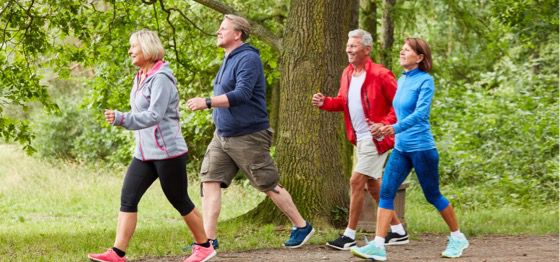According to the Centers for Disease Control and Prevention (CDC), all older adults, men and women, may benefit from regular, moderate exercise. This is true even for seniors with medical conditions such as arthritis, heart disease, obesity, and high blood pressure.1 Additionally, most adults over the age of 65 can exercise safely, even those with chronic conditions and mobility challenges.2
There are 4 basic types of exercise: endurance, strength, balance and flexibility.3 Most seniors tend to focus on 1 type and may think they’re doing enough. But it’s very important to include all 4 because each type offers different benefits.4
As seniors get older, they may lose muscle mass.5 Age-related muscle loss, known as sarcopenia, can begin at around age 35 and occurs at a rate of 1% to 2% a year for the typical person. After age 60, it may accelerate to 3% a year. And, on average, older adults who don’t do regular strength training can expect to lose 4 to 6 pounds of muscle per decade.6
Muscle loss and weakness can accelerate the loss of independence, putting everyday activities—like walking, cleaning, shopping, even dressing—out of reach. They may also hinder seniors’ ability to cope with and recover from illness or injury. Disabilities are 1.5 to 4.6 times more likely to affect older people with moderate to severe sarcopenia than those with normal muscle mass.7
Weak muscles also make it harder to balance properly, so it’s not at all surprising that 1 in every 3 seniors ages 65 and older falls each year.8 Some of these falls may have serious consequences, including bone fractures, admittance to long-term care facilities or even death from complications. According to the CDC, falls lead to more than 800,000 hospitalizations a year.9 But strength training exercises can help.
Benefits of strength exercises for seniors
Strength training exercises can make a big impact on the physical and mental well-being of older adults, offering a range of benefits that may help seniors maintain their health and vitality as they age.10 Here are a few examples:
- Improved joint health – Strength training can be a game changer for older adults’ joint health. As seniors age, joints can become stiff and painful, making it harder to go about daily activities. By strengthening the muscles that support the joints, strength training can help improve joint mobility and reduce pain. This not only reduces the risk of injury, but it also enhances overall physical function.11
- Stronger bones – Strength training is a critical aspect of overall health for older adults, especially when it comes to maintaining strong bones. With age, bones naturally weaken, putting seniors at increased risk for fractures and conditions like osteoporosis. With strength training, older adults can boost bone density by placing stress on the bones, which triggers the body to add new bone tissue.12
- Improved cardiovascular health – Strength training, in addition to its other benefits, may help improve older adults’ heart and circulatory health. Strength training helps boost the heart rate and improves blood flow. It may also help lower blood pressure and reduce bad cholesterol levels. Together, these benefits may help reduce the risk of heart disease, stroke and other cardiovascular conditions.13
- Healthier mind and better brain function – Strength training is more than just a workout for the body—it also has a positive impact on the mind, helping seniors alleviate stress, anxiety and depression through the release of endorphins, the naturally occurring “feel-good” chemicals in the body. This leads to a boost in overall mood and a greater sense of well-being. Strength training may also help the aging brain. Challenging it to coordinate movements and perform exercises with proper form may enhance cognitive function and may even reduce the risk of age-related cognitive decline.14
How to get started with strength training for seniors
The first step older adults should take with a strength training exercise program is to talk with their doctor to determine safety and limitations. Most seniors—even those with chronic health conditions like arthritis, osteoporosis, diabetes, and heart ailments—can likely take part in a strength training program.15
- Use bodyweight to learn the basics
Seniors new to strength training shouldn’t stress about weights or exercise equipment. Instead, they should focus on performing exercises using their own bodyweight, so they can learn proper form and build a base level of strength before adding weights to the mix. This helps reduce the risk of injury while also promoting better results from future workouts. When performing basic bodyweight movements, older adults should work up to performing 3 sets of 10 to 15 repetitions. When that starts feeling easy, it’s time to move on to weighted workouts.16
- Start small and light
Older adults doing strength training exercises with weights should start with the lightest amounts available at home or at the gym, increasing loads as they feel comfortable. Beginning seniors should perform 3 sets of 8 to 12 reps, striving for good form above all. Depending on the exercises in their regimen, seniors can also choose resistance bands as beneficial alternatives to traditional free weights.17
- Consider a personal trainer
Seniors just starting out may benefit from some 1-on-1 lessons. If they need help perfecting their form, older adults should ask their gym about working with a personal trainer. Or they can look for a group class at a local gym or senior center.18
Seniors should strive for exercising all the major muscle groups at least 2 days per week but avoid exercising the same muscle group 2 days in a row.19
Go365 by Humana® makes wellness fun and easy. We help Humana Medicare members with Go365® on their plan reach health goals, as well as take care of their physical and emotional health—allowing members to thrive at any age.
Humana Medicare members with Go365 on their plan can enroll in Go365 at
Go365 is a well-being and rewards program for many Humana Medicare Advantage members. Rewards have no cash value and can only be redeemed in the Go365 Mall. Rewards must be earned and redeemed within the same plan year. Any rewards not redeemed by December 31st will be forfeited.
If you need to enroll in Medicare Advantage or change your plan outside of the usual Medicare Annual Election Period, a Special Election Period (SEP) could be the answer. For information on eligibility, visit Humana’s
To learn more about Humana Medicare Advantage, call to speak with a licensed Humana sales agent at 1-844-321-5843 (TTY:711), Monday – Friday, 8 a.m. – 8 p.m. local time or visit
Sources:
1“Physical Activity and Health: A Report of the Surgeon General,” Centers for Disease Control and Prevention, last accessed February 10, 2023,
2“The Life Changing Benefits of Exercise After 60,” National Council on Aging, last accessed February 10, 2023,
3“Four Types of Exercise Can Improve Your Health and Physical Ability,” National Institute on Aging, last accessed March 21, 2023,
4Elena Volpi, et. al., “Muscle tissue changes with aging,” National Library of Medicine, last accessed February 10, 2023,
5“Strength and Power Training for Older Adults,” Harvard Health Publishing, last accessed February 10,2023,
6“Strength and Power Training for Older Adults.”
7“Strength and Power Training for Older Adults.”
8“Facts About Falls,” Centers for Disease Control and Prevention, last accessed February 10, 2023.
9“Seniors and Exercise,” American Academy of Orthopedic Surgeons,” last accessed February 13, 2023,
10Hallie Levine, “Strength Training’s Surprising Health Benefits,” AARP, last accessed February 13, 2023,
11“Exercise for Your Bone Health,” National Institutes of Health, last accessed February 13, 2023,
12Levine, “Strength Training’s Surprising Health Benefits.”
13“Strength Training’s Surprising Health Benefits”
14“Growing Stronger: Strength Training for Older Adults,” Centers for Disease Control and Prevention, last accessed February 10, 2023.
15K. Aleisha Fetters, “Everything You Need to Know About Strength Training,” Silver Sneakers, last accessed February 13, 2023,
16“Everything You Need to Know About Strength Training”
17“Everything You Need to Know About Strength Training”
18“Four Types of Exercise Can Improve Your Health and Physical Ability,” National Institute on Aging, last accessed February 10, 2023.
Consult your doctor before beginning any new diet or exercise regimen.
This information is provided for educational purposes only. It is not to be used for medical advice, diagnosis or treatment. Consult your healthcare provider if you have questions or concerns.
Go365 is not an insurance product and is not available with all Humana health plans. This is a general description of services which are subject to change. Product features may vary by client. Please refer to Customer Support for more information.
Humana is a Medicare Advantage HMO, PPO and PFFS organization with a Medicare contract. Humana is also a Coordinated Care plan with a Medicare contract and a contract with the state Medicaid program. Enrollment in any Humana plan depends on contract renewal.






